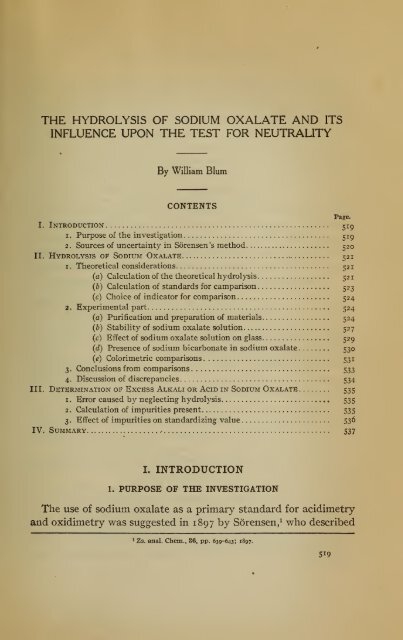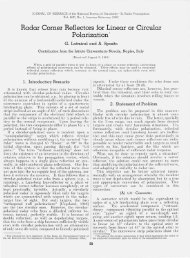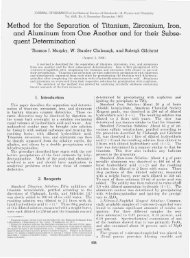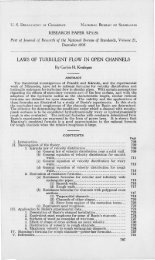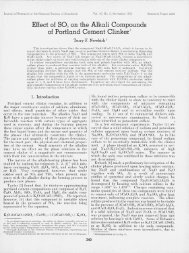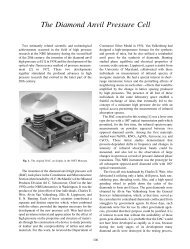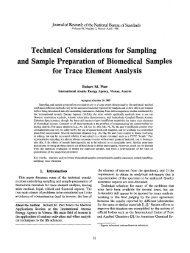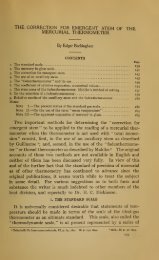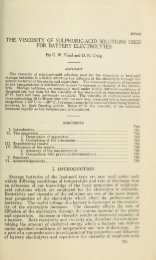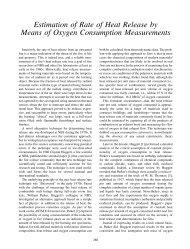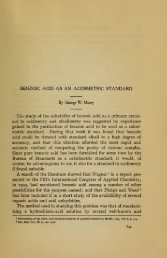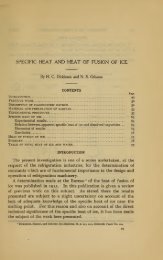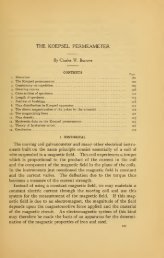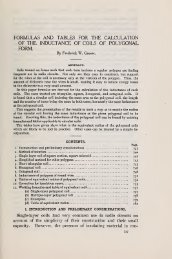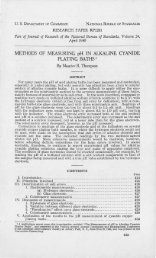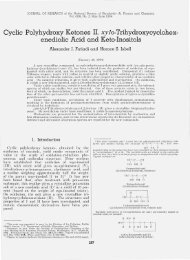The hydrolysis of sodium oxalate and its influence upon the test for ...
The hydrolysis of sodium oxalate and its influence upon the test for ...
The hydrolysis of sodium oxalate and its influence upon the test for ...
You also want an ePaper? Increase the reach of your titles
YUMPU automatically turns print PDFs into web optimized ePapers that Google loves.
THE HYDROLYSIS OF SODIUM OXALATE AND ITS<br />
INFLUENCE UPON THE TEST FOR NEUTRALITY<br />
By William Blum<br />
CONTENTS<br />
Page.<br />
I. Introduction 519<br />
1. Purpose <strong>of</strong> <strong>the</strong> investigation ^19<br />
2 Sources <strong>of</strong> uncertainty in Sorensen 's method 520<br />
II. Hydrolysis oi^ Sodium Oxalate; 521<br />
1. <strong>The</strong>oretical considerations 521<br />
(a) Calculation <strong>of</strong> <strong>the</strong> <strong>the</strong>oretical <strong>hydrolysis</strong> 521<br />
(6) Calculation <strong>of</strong> st<strong>and</strong>ards <strong>for</strong> camparison 523<br />
(c) Choice <strong>of</strong> indicator <strong>for</strong> comparison 524<br />
2. Experimental part 524<br />
(a) Purification <strong>and</strong> preparation <strong>of</strong> materials 524<br />
(6) Stability <strong>of</strong> <strong>sodium</strong> <strong>oxalate</strong> solution 527<br />
(c) Effect <strong>of</strong> <strong>sodium</strong> <strong>oxalate</strong> solution on glass 529<br />
(d) Presence <strong>of</strong> <strong>sodium</strong> bicarbonate in <strong>sodium</strong> <strong>oxalate</strong>. ....... 530<br />
(e) Colorimetric comparisons 531<br />
3. Conclusions from comparisons 533<br />
4. Discussion <strong>of</strong> discrepancies 534<br />
III. Determination oi^ Excess Alkali or Acid in Sodium Oxalate 535<br />
1. Error caused by neglecting <strong>hydrolysis</strong> 535<br />
2. Calculation <strong>of</strong> impurities present 535<br />
3 Effect <strong>of</strong> impurities on st<strong>and</strong>ardizing value 536<br />
IV. Summary 537<br />
I. INTRODUCTION<br />
1. PURPOSE OF THE INVESTIGATION<br />
<strong>The</strong> use <strong>of</strong> <strong>sodium</strong> <strong>oxalate</strong> as a primary st<strong>and</strong>ard <strong>for</strong> acidimetry<br />
<strong>and</strong> oxidimetry was suggested in 1897 by Sorensen/ who described<br />
1 Zs. anaL Chem., 36, pp. 639H543; 1897.
520 Bulletin <strong>of</strong> <strong>the</strong> Bureau <strong>of</strong> St<strong>and</strong>ards [Voi.s.No.j<br />
<strong>its</strong> preparation, <strong>test</strong>ing, <strong>and</strong> use in subsequent papers.^ Its general<br />
adoption as a st<strong>and</strong>ard has been hindered by <strong>the</strong> difficulty <strong>of</strong><br />
securing from <strong>the</strong> manufacturers material <strong>of</strong> a purity con<strong>for</strong>ming<br />
to <strong>the</strong> specifications prepared by Sorensen.^ In order to determine<br />
<strong>the</strong> composition <strong>of</strong> <strong>sodium</strong> <strong>oxalate</strong> as purchased, <strong>and</strong> to secure, if<br />
possible, a material <strong>of</strong> <strong>the</strong> requisite purity to issue as a st<strong>and</strong>ard<br />
sample, specimens <strong>of</strong> <strong>sodium</strong> <strong>oxalate</strong> were obtained by purchase<br />
in <strong>the</strong> open market or directly from <strong>the</strong> maker, from two European<br />
<strong>and</strong> three American manufactiu-ers. In <strong>the</strong> course <strong>of</strong> <strong>the</strong> subsequent<br />
<strong>test</strong>s <strong>the</strong> methods described by Sorensen were found satisfactory,<br />
with <strong>the</strong> exception <strong>of</strong> that <strong>for</strong> <strong>the</strong> determination <strong>of</strong> <strong>sodium</strong><br />
carbonate or <strong>sodium</strong> acid <strong>oxalate</strong>, in which discrepancies were<br />
foimd, which led to <strong>the</strong> following investigation. Sorensen's<br />
directions are stated in <strong>the</strong> following paragraph ; <strong>and</strong> an improved<br />
method, based <strong>upon</strong> this investigation, is described in <strong>the</strong> summary.<br />
2. SOURCES OF UNCRERTAINTY IN SORENSEN'S METHOD<br />
Sorensen's method <strong>for</strong> <strong>test</strong>ing <strong>the</strong> neutrality <strong>of</strong> <strong>the</strong> <strong>sodium</strong><br />
<strong>oxalate</strong> is as follows: "Introduce into a conical Jena flask about<br />
250 cc <strong>of</strong> water <strong>and</strong> 10 drops <strong>of</strong> phenolphthalein solution (0.5 g<br />
phenolphthalein dissolved in 50 cc alcohol <strong>and</strong> 50 cc <strong>of</strong> water),<br />
<strong>and</strong> evaporate to 180 cc while passing in a current <strong>of</strong> pure air, free<br />
from carbon dioxide. Allow to cool to <strong>the</strong> ordinary temperature<br />
<strong>and</strong> add 5 g <strong>of</strong> sodiimi <strong>oxalate</strong>. Upon shaking carefully, while<br />
maintaining <strong>the</strong> current <strong>of</strong> air, <strong>the</strong> <strong>oxalate</strong> slowly dissolves. If<br />
<strong>the</strong> solution is red, not more than 4 drops <strong>of</strong> decinormal acid<br />
should be required to render it colorless, while if <strong>the</strong> solution is<br />
colorless, it should acquire a distinct red color <strong>upon</strong> <strong>the</strong> addition<br />
<strong>of</strong> not more than 2 drops <strong>of</strong> decinormal <strong>sodium</strong> hydroxide."<br />
Preliminary experiments showed that <strong>the</strong> following points in<br />
<strong>the</strong> above method required investigation:<br />
(a) Is pure <strong>sodium</strong> <strong>oxalate</strong> neutral toward phenolphthalein, or<br />
is <strong>the</strong> <strong>hydrolysis</strong> sufficient to produce an alkaline reaction ?<br />
(b) Does <strong>sodium</strong> <strong>oxalate</strong> solution decompose on boiling, or is<br />
<strong>the</strong> increased alkalinity due to <strong>its</strong> action <strong>upon</strong> <strong>the</strong> glass ?<br />
2Zs. anal. Chem., 42, pp. 333-359 <strong>and</strong> 512-516; 1903.<br />
3 Merck "Priifung der Chemisclien Reagenzien avif Reinheit," 1905, <strong>and</strong> Krauch-Merck "Chemical<br />
Reagents," 1907.
Blum] Hydrolysis <strong>of</strong> Sodium Oxalate 5^1<br />
(c) Is any excess alkali present entirely in <strong>the</strong> <strong>for</strong>m <strong>of</strong> NagCOg,<br />
or may NaHCOg actually exist in a material heated to 240° C?<br />
(J) Under given conditions <strong>of</strong> titration, to what <strong>for</strong>m should <strong>the</strong><br />
excess alkali or acid be calculated, <strong>and</strong> what errors in <strong>the</strong> use <strong>of</strong><br />
<strong>sodium</strong> <strong>oxalate</strong> as an acidimetric or oxidimetric st<strong>and</strong>ard are<br />
caused by <strong>the</strong> presence <strong>of</strong> a given excess <strong>of</strong> acid or alkali?<br />
11. THE HYDROLYSIS OF SODIUM OXALATE<br />
1. THEORETICAL CONSIDERATIONS<br />
Souchay <strong>and</strong> Lenssen * stated that ''<strong>the</strong> aqueous solution does<br />
not affect curcuma paper, but blues red litmus paper, especially<br />
on boiling." Sorensen ^ considered that <strong>the</strong> slightly alkaline<br />
reaction which most <strong>of</strong> his preparations showed tow^ard phenolphthalein<br />
was probably due to a trace <strong>of</strong> <strong>sodium</strong> carbonate, though<br />
admitting <strong>the</strong> possibility <strong>of</strong> alkalinity due to <strong>hydrolysis</strong>, in <strong>the</strong><br />
sense <strong>of</strong> <strong>the</strong> equation<br />
Na^C^O^ + H2O = NaOH + NaHC204.<br />
Since <strong>the</strong> apparent alkalinity <strong>of</strong> his samples (a maximum <strong>of</strong> about<br />
0.05 per cent Na2C03) represented a negligible error when used<br />
as an acidimetric st<strong>and</strong>ard, Sorensen dismissed <strong>the</strong> subject with-<br />
out fur<strong>the</strong>r study.<br />
(a) CALCULATION OF THE THEORETICAL HYDROLYSIS<br />
<strong>The</strong> <strong>hydrolysis</strong> <strong>of</strong> <strong>sodium</strong> <strong>oxalate</strong> may be represented thus:<br />
Na2C204 -h H20^NaHC204 + NaOH<br />
which may be expressed as follows in terms <strong>of</strong> ions:<br />
Na2C204
522 Bulletin <strong>of</strong> <strong>the</strong> Bureau <strong>of</strong> St<strong>and</strong>ards [Voi.s.no.j<br />
acid, which is only about one-thous<strong>and</strong>th <strong>of</strong> that <strong>of</strong> <strong>the</strong> first hydro-<br />
gen <strong>of</strong> this acid.® In such a solution, <strong>the</strong>re<strong>for</strong>e [HC2O4-], is prac-<br />
tically equal to [OH"], while [C204"~] is equal to <strong>the</strong> product <strong>of</strong><br />
<strong>the</strong> concentration <strong>of</strong> <strong>the</strong> salt, <strong>and</strong> <strong>its</strong> ionization. Thus<br />
[HC,Or] = [OH-] K,, = ^^[KC,o/]~^<br />
[C,0r-]=7C i^, = [H^] [0H-]<br />
where c = molar concentration <strong>of</strong> <strong>the</strong> solution, i. e., <strong>the</strong> number <strong>of</strong><br />
gram molecules in one liter <strong>of</strong> <strong>the</strong> solution.<br />
7 = ionization <strong>of</strong> <strong>the</strong> salt.<br />
K^^2 = ionization constant <strong>for</strong> <strong>the</strong> second H <strong>of</strong> H2C2O4.<br />
K^ = ionization constant <strong>for</strong> HjO.<br />
By substitution [H<br />
To calculate [H"^] <strong>for</strong> 0.1 M (molar) solution <strong>of</strong> <strong>sodium</strong> <strong>oxalate</strong>,<br />
<strong>the</strong> following values were employed:<br />
K^, =4.5X10-^ C)<br />
X^25o = i-iXio-i* <strong>and</strong>i^^ 180=0.6X10-^* 0)<br />
7 =0.7 e)<br />
6 Ch<strong>and</strong>ler, J. Am. Chem. Soc, 30, pp. 694-713; 1908.<br />
^ Ch<strong>and</strong>ler, J. Am. Chem. Soc, 30, pp. 694-713; 1908, foiind by partition experiments 4. i X 10"^, <strong>and</strong> by<br />
conductivity, 4.9 X lo"^. <strong>The</strong> mean value, 4.5 X 10"= has been employed <strong>for</strong> both 18° <strong>and</strong> 25°, although<br />
determined by Ch<strong>and</strong>ler at 25°; since <strong>the</strong> temperature coefficient is probably less than <strong>the</strong> uncertainty in<br />
<strong>the</strong> value <strong>for</strong> 25°.<br />
25° 18°<br />
8 Derived from <strong>the</strong> following values: KXio^* KXici^*<br />
Arrhenius, Zs. phys. Chem., 11, p. 805; 1893<br />
Wijs & Van't H<strong>of</strong>f, Zs. phys. Chem., 12, p. 514; 1893<br />
i. 2<br />
i. 4 a 64<br />
Lowenherz, Zs. phys. Chem. , 20, p. 283 ; 1896<br />
Kanolt, J. Am. Chem. Soc. , 29, p. 1402 ; 1907<br />
Hudson, J. Am. Chem. Soc. ,31, p. 1130; 1909<br />
Lorenz & Bohi, Zs. phys. Chem. , 66, p. 733 ; 1909<br />
i. 4<br />
o. 8<br />
i. o<br />
i. 2<br />
o- 46<br />
o. 72<br />
HeydweUler, Ann. phys. , 28, p. 503 ; 1909 i. o 0-59<br />
(Recalc. from Kohlrausch & Heydweiller, Wied. Ann., 53, p. 709; 1894.)<br />
Mean 1. o. 60<br />
5 Kohlrausch (" Leitvermogen der Elektrolyte," p. 161; 1898) <strong>and</strong> Noyes <strong>and</strong> Johnston (J. Am. Chem.<br />
Soc., 31, p. 987; 1909) both found <strong>for</strong> o.i M K2C20< at 18°, r=o.7; which value has been assimied to hold <strong>for</strong><br />
Na2C204.
Blum] Hydrolysis <strong>of</strong> Sodium Oxalate 523<br />
Round number<br />
employed.<br />
which [H+]i8o =1.96X10-^ 2.0X10-^<br />
<strong>and</strong>[OH-]i8o = 3.o6Xio-« 3.IX1O-'<br />
[H-+]25o =2.66Xio-« 2.7X10-^<br />
[OH-]25o=4-i4Xio-« 4.1 X 10-^<br />
In <strong>the</strong> subsequent calculations <strong>the</strong> round numbers indicated<br />
have been employed.<br />
(b) CALCULATION OF STANDARDS FOR COMPARISON<br />
For <strong>the</strong> purpose <strong>of</strong> comparison, st<strong>and</strong>ards <strong>of</strong> calculated alkalinity<br />
were prepared from mixtures <strong>of</strong> ammonium chloride <strong>and</strong><br />
hydroxide, on <strong>the</strong> following basis. <strong>The</strong> ionization constant ^^<br />
<strong>of</strong> ammonium hydroxide at 25° = 1.8 X IO~^ i. e.,<br />
[NH/][OH-] _ [NH/] _ i.8Xio-^<br />
i-»^io ana|-^^^^jj^<br />
[NH.OH]<br />
^^^_^<br />
• • [NH4OH]<br />
[NH/] _ i.8Xio-^ _<br />
4.1X10-^<br />
Since, however, 0.1 N NH^Cl is about 85 per cent ionized",<br />
it is necessary to use 4.4 -^ .85 = 5.2 parts <strong>of</strong> o.i iV NH4CI to i part<br />
0.1 A^ NH4OH to prepare a solution in which [H+]25o = 2.7X lO"^<br />
A second comparison was made with 0.1 N <strong>sodium</strong> acetate, <strong>for</strong><br />
which <strong>the</strong> following constants were employed:<br />
^'"^<br />
x^,= 1.8x10-^ e^)<br />
7 = 0.8<br />
fromwhich[HT = -*/^^^^" = i.6Xio-«<br />
i. e., 0.1 N sodirun acetate should be slightly more alkaline than<br />
<strong>sodium</strong> <strong>oxalate</strong>.<br />
Mixtures <strong>of</strong> o. i N <strong>sodium</strong> borate <strong>and</strong> hydrochloric acid, <strong>and</strong> <strong>of</strong><br />
glycocoll <strong>and</strong> <strong>sodium</strong> hydroxide, were also prepared, according to<br />
1" Noyes <strong>and</strong> Sosman, "Electrical Conductivity <strong>of</strong> Aqueous Solutions," Cam. Inst. Pub., 63, p. 228; 1908.<br />
11 Calculated from Kohlrausch, " Leitvermogen der Elektrolyte, " p. 159; 1898.<br />
12 Noyes <strong>and</strong> Sosman, loc. cit.
5^4 Bulletin <strong>of</strong> <strong>the</strong> Bureau <strong>of</strong> St<strong>and</strong>ards [Voi.s.no.s<br />
Sorensen/^ who calculated [H^Ji^o <strong>for</strong> such solutions from emf<br />
measurements with a hydrogen electrode. ^^ As his measm*ements<br />
w^ere made at i8°, <strong>the</strong> observations were confined to that tem-<br />
perature.<br />
(c) CHOICE OF INDICATOR FOR COMPARISON<br />
Preliminary <strong>test</strong>s showed that phenolphthalein is <strong>the</strong> only<br />
indicator that is sensitive in solutions <strong>of</strong> exactly this alkalinity.<br />
Alizarin, cyanin, <strong>and</strong> dinitro-hydroquinone all proved unsatis-<br />
factory <strong>for</strong> accurate matching, though <strong>the</strong> latter was sufficiently<br />
sensitive to confirm approximately <strong>the</strong> results with phenolphtha-<br />
lein. <strong>The</strong> indicator selected <strong>for</strong> <strong>the</strong> final comparison was <strong>the</strong>re<strong>for</strong>e<br />
phenolphthalein, <strong>for</strong> which <strong>the</strong> most probable value ^^ <strong>of</strong> K is<br />
1.7X10"^°. In a solution in which [H+]25° =2.7X io~^ this indi-<br />
cator should <strong>the</strong>re<strong>for</strong>e be trans<strong>for</strong>med into <strong>its</strong> salt ^® to <strong>the</strong> extent<br />
<strong>of</strong> 5.9 per cent.<br />
[H-][ii_ -.0<br />
[HI] = 1.7X10-<br />
Pi _ i.7Xio-^^ _ ,__5:9<br />
[HI] ~2.7Xio-^ ~ ^^^ ~94.i<br />
<strong>The</strong>se calculations are based <strong>upon</strong> <strong>the</strong> assumption that <strong>the</strong><br />
ionization constant <strong>of</strong> phenolphthalein is <strong>the</strong> same at 18° <strong>and</strong><br />
25°, <strong>and</strong> that <strong>the</strong> color <strong>of</strong> <strong>the</strong> indicator is not materially affected<br />
by <strong>the</strong> presence <strong>of</strong> neutral salts.<br />
2. EXPERIMENTAL PART<br />
(a) PURIFICATION AND PREPARATION OF MATERIALS AND SOLUTIONS<br />
Air.—Air was freed from carbon dioxide by passage through two<br />
wash bottles containing 30 per cent potassium hydroxide <strong>and</strong> a<br />
i^Sorensen, Compt. Rend. Trav. Lab. Carlsberg, 8, pp. 1-168; 1910, <strong>and</strong> Biochem. Zs., 21, pp. 131-304;<br />
1910.<br />
'^ Several <strong>of</strong> Sorensen's mixtures were checked electrometrically <strong>and</strong> colorLmetrically by Auerbach <strong>and</strong><br />
Pick, Arbeit Kais. Gesundhc<strong>its</strong>amte, 38, pp. 243-274; 1911.<br />
15 Hildebr<strong>and</strong>, Zs. Elektrochem., 14, p. 351.<br />
Wegscheider, Zs. Elektrochem., 14, p. 510.<br />
Rosenstein (ISIass. Inst. Tech.), Private communication from W. C. Bray.<br />
1^ Noyes, J. Am. Chem. Soc, 32, p. 861; 1910.
Blum] Hydrolysis <strong>of</strong> Sodium Oxalate 5^5<br />
U tube with a lo-inch column <strong>of</strong> soda-lime, followed by absorbent<br />
cotton.<br />
Water.—<strong>The</strong> regular distilled water was redistilled from alka-<br />
line permanganate. It was <strong>the</strong>n boiled in a seasoned Jena flask<br />
<strong>for</strong> two hoiurs in a stream <strong>of</strong> pure air <strong>and</strong> preserved in a Jena<br />
flask provided with a siphon <strong>and</strong> a soda-lime guard tube. This<br />
water had a specific conductivity <strong>of</strong> 2 x lO"^ reciprocal ohms <strong>and</strong><br />
evolved no carbon dioxide when a small portion was boiled <strong>for</strong><br />
one-half hour in a stream <strong>of</strong> pure air, which after being dried with<br />
calcium chloride was passed through a weighed soda-lime tube.<br />
Sodium <strong>oxalate</strong>.— Piu-e <strong>sodium</strong> <strong>oxalate</strong> was prepared from two<br />
commercial samples. One, designated A, contained originally<br />
(as determined in <strong>the</strong> final <strong>test</strong>s) 0.02 per cent NaHC204; while<br />
that marked B contained 0.04 per cent NajCOg, <strong>and</strong> considerable<br />
CaC204. <strong>The</strong>se materials were recrystallized in platinum, <strong>the</strong><br />
solutions being electrically heated, <strong>and</strong> <strong>the</strong> . surrounding atmosphere<br />
being kept as free from carbon dioxide as possible. <strong>The</strong><br />
fine crystals obtained were sucked dry on a platinum cone <strong>and</strong> dried<br />
in an electric oven at 240°. A portion <strong>of</strong> <strong>the</strong> product <strong>of</strong> <strong>the</strong> third<br />
recrystallization <strong>of</strong> B was dissolved in water <strong>and</strong> precipitated by<br />
<strong>the</strong> addition <strong>of</strong> double distilled neutral alcohol, <strong>the</strong> product being<br />
filtered out <strong>and</strong> dried as above. <strong>The</strong> following samples <strong>of</strong> <strong>sodium</strong><br />
<strong>oxalate</strong> were thus obtained:<br />
Water crystallization A^, A2; B^, B2, B3.<br />
Alcohol precipitation B4.<br />
Since in subsequent <strong>test</strong>s <strong>the</strong>se samples were found to produce<br />
almost <strong>the</strong> same colors with phenolphthalein, we may conclude<br />
that a single water crystallization eliminated practically all <strong>of</strong> <strong>the</strong><br />
impurities above noted; <strong>and</strong> as a constant <strong>and</strong> uni<strong>for</strong>m product<br />
was obtained by recrystallization <strong>of</strong> materials originally respec-<br />
tively acid <strong>and</strong> alkaline, it is reasonably certain that <strong>the</strong> product<br />
represented pure <strong>sodium</strong> <strong>oxalate</strong>.<br />
Ammonium chloride.—A normal solution was prepared from<br />
J. T. Baker's special ammonium chloride, dried at 110° <strong>for</strong> two<br />
hours. This material was found to contain no organic bases when<br />
<strong>test</strong>ed according to Krauch.
526 Bulletin <strong>of</strong> <strong>the</strong> Bureau <strong>of</strong> St<strong>and</strong>ards [Voi.s.no.j<br />
Ammonium hydroxide.— Decinormal solution was prepared<br />
from redistilled ammonia <strong>and</strong> st<strong>and</strong>ardized against decinorm.al<br />
hydrochloric acid, which in turn was st<strong>and</strong>ardized gravimetri-<br />
cally by means <strong>of</strong> silver chloride. Methyl red was used as <strong>the</strong><br />
indicator. <strong>The</strong> solution was preserved in a ceresin-lined bottle<br />
<strong>and</strong> measured in a birrette closed with a soda-lime tube.<br />
Sodium hydroxide.— Pure m^aterial was prepared from metallic<br />
<strong>sodium</strong> with exclusion <strong>of</strong> carbon dioxide. ^^ <strong>The</strong> resulting strong<br />
solution was titrated against st<strong>and</strong>ard hydrochloric acid <strong>and</strong><br />
diluted to centinormal solution, which was preserved in a ceresin-<br />
lined bottle.<br />
Oxalic acid.—^A centinormal solution was prepared from J. T.<br />
Baker's crystallized oxalic acid.<br />
Sodium acetate.— Merck's crystallized sodiimi acetate was<br />
recrystallized in platinum. <strong>The</strong> products <strong>of</strong> <strong>the</strong> crystallizations<br />
were sucked dry on a platinum cone, dried between filter paper,<br />
<strong>and</strong> finally air-dried.<br />
Sodium borate (Na2B407) solution was prepared from equiva-<br />
lent quantities <strong>of</strong> twice recrystallized boric acid <strong>and</strong> pure sodiiun<br />
hydroxide.<br />
Glycocoll (amino-acetic acid) solution was prepared according<br />
to Sorensen by dissolving 7.505 g glycocoll (Kahlbaum) <strong>and</strong> 5.85<br />
g <strong>sodium</strong> chloride in i liter.<br />
Phenolphthalein.—A i per cent alcoholic solution <strong>of</strong> <strong>the</strong> indi-<br />
cator was employed, i. e., about 0.03 N. In each comparison<br />
exactly 0.2 cc <strong>of</strong> this solution was employed in a total volume <strong>of</strong><br />
150 cc, thus giving a solution in which <strong>the</strong> phenolphthalein is<br />
about N, According to McCoy ^^ <strong>the</strong> saturated aqueous<br />
solution <strong>of</strong> this indicator is about A^. A solution <strong>of</strong> such<br />
1 1000<br />
concentration (i. e., 0.4 cc in 150 cc) was, however, always turbid,<br />
so that <strong>the</strong> smaller concentration was employed, giving a color <strong>of</strong><br />
17 Findlay, Practical Physical Chemistry, p. 176; 1906. i^ Am. Chem. J., 31, p. 503; 1904.
Blum] Hydrolysis <strong>of</strong> Sodium Oxalate 527<br />
convenient intensity <strong>for</strong> comparison. Alcohol was not present in<br />
amount sufficient to affect <strong>the</strong> color ^^ <strong>of</strong> <strong>the</strong> indicator.<br />
(b) STABILITY OF SODIUM-OXALATE SOLUTIONS<br />
Be<strong>for</strong>e attempting to prepare <strong>and</strong> <strong>test</strong> pure <strong>sodium</strong> <strong>oxalate</strong> it<br />
was necessary to determine <strong>the</strong> effect <strong>of</strong> heat <strong>upon</strong> <strong>its</strong> solution.<br />
Sorensen^o found that a <strong>sodium</strong> <strong>oxalate</strong> solution became more<br />
alkaline <strong>upon</strong> boiling, whe<strong>the</strong>r in water that had previously been<br />
boiled or not, <strong>and</strong> equally in a stream <strong>of</strong> air, oxygen, or nitrogen.<br />
He attributed <strong>the</strong> increased alkalinity to a decomposition in <strong>the</strong><br />
sense <strong>of</strong> <strong>the</strong> equation<br />
2Na2C204 + H2O = CO2 + Na^COe + 2HC00Na<br />
quoting Carles ^^ who found that oxalic- acid solution decomposed<br />
similarly if boiled in a stream <strong>of</strong> an inert gas.<br />
That no appreciable decomposition takes place <strong>upon</strong> boiling<br />
<strong>sodium</strong>-<strong>oxalate</strong> solution was shown by <strong>the</strong> following experiments:<br />
Five grams <strong>of</strong> <strong>the</strong> salt were boiled with piu-e water in a stream<br />
<strong>of</strong> pure air, which was passed through calcium chloride <strong>and</strong> <strong>the</strong>n<br />
through a weighed soda-lime tube. <strong>The</strong> latter was reweighed at<br />
<strong>the</strong> end <strong>of</strong> two hours, replaced, <strong>and</strong> <strong>the</strong> solution acidified <strong>and</strong><br />
again boiled to determine whe<strong>the</strong>r any sodiiun carbonate was<br />
<strong>for</strong>med in <strong>the</strong> boiling <strong>of</strong> <strong>the</strong> aqueous solution. <strong>The</strong> amount <strong>of</strong><br />
carbon dioxide evolved on direct acidification was also determined.<br />
<strong>The</strong> apparatus <strong>and</strong> method were <strong>test</strong>ed with known small quan-<br />
tities <strong>of</strong> <strong>sodium</strong> carbonate.<br />
19 McCoy, Am. Chem. J., 31, p. 503; 1904.<br />
Hildebr<strong>and</strong>, Zs. Elektrochem., 14, p. 351, 1908; <strong>and</strong> J. Am. Chem. Soc, 30, p. 1914, 1908.<br />
20 Zs. Anal. Chem., 42, p. 352; 1903.<br />
*i Compt. rend., 71, p. 226; 1870.
528 Bulletin <strong>of</strong> <strong>the</strong> Bureau <strong>of</strong> St<strong>and</strong>ards<br />
TABLE I<br />
[Vol. 8, No. 3<br />
Evolution <strong>of</strong> Carbon Dioxide on Boiling Solutions Containing 5 Grams <strong>of</strong><br />
Sodium Oxalate<br />
Expt. Sample Solution Time Weight <strong>of</strong> CO2<br />
minutes mg<br />
1 A Acidified 15 0.3<br />
2a « Aqueous 15 0.0<br />
b (( " + 120 0.2<br />
c « Acidified + 15 0.2<br />
3a B "<br />
15 1.3<br />
b « • 30 1.4<br />
4a " Aqueous 15 0.6<br />
b
Blum] Hydrolysis <strong>of</strong> Sodium Oxalate<br />
TABLE II<br />
(c) Effect <strong>of</strong> Sodium Oxalate Solutions <strong>upon</strong> Glass<br />
Increased Alkalinity, in terms <strong>of</strong> 0.01 N Oxalic Acid<br />
Expt. Glass Sodium <strong>oxalate</strong> Time<br />
529<br />
Volume <strong>of</strong> 0.01 N<br />
H2C2O4<br />
minutes cc<br />
la Quartz A 120 0.0<br />
b<br />
c<br />
d<br />
530 Bulletin <strong>of</strong> <strong>the</strong> Bureau <strong>of</strong> St<strong>and</strong>ards [Vol. 8, No.<br />
(d) PRESENCE OF SODIUM BICARBONATE IN SODIUM OXALATE<br />
Sorensen dismissed <strong>the</strong> question <strong>of</strong> <strong>the</strong> existence <strong>of</strong> NaHCOg by<br />
stating that it could not possibly be present in material dried at<br />
240°, since it decomposes at or below 100°. In <strong>the</strong> course <strong>of</strong> <strong>the</strong><br />
<strong>test</strong>ing, however, it was found that several <strong>of</strong> <strong>the</strong> samples when<br />
dissolved in pure water containing phenolphthalein were colorless,<br />
or nearly so, but after a few minutes' boiling became strongly piiik<br />
<strong>and</strong> remained pink on cooling, indicating <strong>the</strong> presence <strong>of</strong> appre-<br />
ciable excess alkali, which would have been overlooked if <strong>test</strong>ed<br />
according to Sorensen. Such samples, e. g., B, evolved carbon<br />
dioxide <strong>upon</strong> boiling <strong>the</strong> aqueous solution, <strong>and</strong> <strong>upon</strong> boiling with<br />
acid evolved a total amount <strong>of</strong> carbon dioxide greater than would<br />
correspond to <strong>the</strong> titrated alkalinity if calculated as NaaCOg.<br />
From Table III it may be seen that in every case <strong>the</strong> gravimetric<br />
<strong>and</strong> volumetric results agreed more closely if calculated to NaHCOg<br />
than to NasCOg, <strong>and</strong> that in all but E <strong>the</strong> carbon dioxide is apparently<br />
even in excess <strong>of</strong> that calculated <strong>for</strong> NaHCOg.<br />
TABLE III<br />
Determination <strong>of</strong> Excess Alkali in Sodium Oxalate<br />
Ei-pt. Sample<br />
Gravimetric determination <strong>of</strong> CO2,<br />
calculated as—<br />
Volumetric determination <strong>of</strong> alkali,<br />
calculated as—<br />
NaaCOs NaHCOs Na2C03 NaHCOs<br />
Per cent Per cent Per cent Per cent<br />
I B 0.065 0.051 0.036 0.057<br />
2 c 0.291 0.230 0.107 0.171<br />
3 D 0.308 0.244 0.120 0.192<br />
4 E 1.31 1.05 0.70 1.11<br />
It is evident, <strong>the</strong>re<strong>for</strong>e, that if such samples were <strong>test</strong>ed with <strong>the</strong><br />
object <strong>of</strong> making corrections <strong>for</strong> accurate work, appreciable errors<br />
might arise if <strong>the</strong> alkalinity were calculated to NasCOg. For<br />
samples containing less impurity than B <strong>the</strong> differences would be<br />
entirely negligible.<br />
With our present m.eans <strong>of</strong> analysis it is impossible to state<br />
whe<strong>the</strong>r such "excess" carbon dioxide (above NaoCOg) is present
Hydrolysis <strong>of</strong> Sodium Oxalate<br />
as XaHCOa or ^ some occluded <strong>for</strong>m. That it is not readily given<br />
<strong>of</strong>f at 240° was shown in E, which lost only 0.14 per cent in two<br />
hours' heating at 240^. though it contained about 0.40 per cent <strong>of</strong><br />
such excess "carbonic acid." When we consider that as usuaDy<br />
prepared (by neutralization <strong>of</strong> oxalic acid with <strong>sodium</strong> carbonate)<br />
<strong>the</strong> salt separates from a solution charged with carbon dioxide, it<br />
is not impossible that <strong>the</strong> latter should be occluded in it, in a <strong>for</strong>m<br />
in which it is not readily expelled at high temperatures; just as<br />
water has been shown to exist in materials heated to high tem-<br />
peratures.^<br />
532 Bulletin <strong>of</strong> <strong>the</strong> Bureau <strong>of</strong> St<strong>and</strong>ards [Voi.8,no.3<br />
ammonium chloride, in order to reduce <strong>the</strong> neutral salt effect. ^^<br />
In <strong>the</strong>se <strong>test</strong>s it was hoped that by making all <strong>the</strong> solutions o.i N<br />
<strong>the</strong> neutral salt effect would be largely eliminated. (From <strong>the</strong><br />
st<strong>and</strong>point <strong>of</strong> <strong>hydrolysis</strong>, o.i M <strong>sodium</strong> <strong>oxalate</strong> may be considered<br />
as O.I N.)<br />
From Sorensen's chart, mixtures <strong>of</strong> 7.06 cc <strong>of</strong> 0.1 N NaaB^Oy<strong>and</strong><br />
2.94 cc O.I A^ HCl, or <strong>of</strong> 9.34 cc glycocoll solution <strong>and</strong> .66 cc 0.1 N<br />
NaOH, produce solutions in which [H+]i8°=2.o x lo"^ (i. e.,<br />
lo-^"^). Mixtiures in <strong>the</strong>se proportions were prepared with a total<br />
volume <strong>of</strong> 150 cc.<br />
Phenolphthalein solutions <strong>of</strong> calculated trans<strong>for</strong>mation were<br />
prepared 27 by adding an accurately measured amount (0.2 cc) <strong>of</strong><br />
phenolphthalein to 150 cc <strong>of</strong> water containing 10 cc <strong>of</strong> 0.1 N<br />
<strong>sodium</strong> hydroxide, whereby <strong>the</strong> indicator was completely trans<strong>for</strong>med<br />
into <strong>its</strong> red salt. Measured portions <strong>of</strong> this solution were<br />
<strong>the</strong>n diluted to 150 cc to produce <strong>the</strong> st<strong>and</strong>ards representing<br />
desired percentage trans<strong>for</strong>mation. In each solution it is <strong>of</strong> course<br />
necessary to have 0.2 cc <strong>of</strong> <strong>the</strong> original phenolphthalein solution<br />
in <strong>the</strong> same total volume.<br />
<strong>The</strong> following comparisons were made by direct optical matching<br />
<strong>of</strong> <strong>the</strong> solutions in <strong>the</strong> Durax flasks, which were all <strong>of</strong> <strong>the</strong> same<br />
shape <strong>and</strong> size. Attempts to use a colorimeter proved unsatis-<br />
factory, owing to <strong>the</strong> very light colors <strong>of</strong> <strong>the</strong> solutions <strong>and</strong> to very<br />
rapid fading <strong>of</strong> <strong>the</strong> <strong>sodium</strong> <strong>oxalate</strong> <strong>and</strong> acetate solutions <strong>upon</strong><br />
exposure to air <strong>and</strong> even sHght absorption <strong>of</strong> carbon dioxide.<br />
<strong>The</strong> results are expressed in percentage trans<strong>for</strong>mation <strong>of</strong> phe-<br />
nolphthalein, <strong>the</strong> st<strong>and</strong>ards <strong>for</strong> which did not vary appreciably in<br />
color between 18° <strong>and</strong> 25°.<br />
26Micliaelis & Rona, Zs. Elektrochem. , 14, pp. 251-253, 1908, <strong>and</strong> Biochem. Zs., 23, pp. 61-67; 1909.<br />
Bohdan V. Szyszkowski, Zs. Physik. Chem., 58, p. 420; 1907. Sorensen <strong>and</strong> Palitzsch, Biochem. Zs., 24,<br />
p. 387; 1910.<br />
27 Noyes, J. Am. Chem. Soc, 32, p. 826; 1910.
Blum] Hydrolysis <strong>of</strong> Sodium Oxalate<br />
Expt.<br />
Solution<br />
TABLE IV<br />
Colorimetric Comparisons<br />
Composition or<br />
Ratio<br />
COLOR<br />
Per cent Trans<strong>for</strong>mation <strong>of</strong> Phenolphthalein<br />
25° 18°<br />
Calc. Obs. Calc. Obs.<br />
1 Na2C204-Bi 0.1 M 5.9 3.5 7.8 4.0<br />
2 " Ba 0.1 M 5.9 3.5 7.8 3.5<br />
3 " Bs 0.1 M 5.9 4.0 7.8 4.0<br />
4 " B4 0.1 M 5.9 4.0 7.8 4.0<br />
5 '• Ai 0.1 M 5.9 4.0 7.8 4.0<br />
6 " Aa 0.1 M 5.9 4.0 7.8 4.0<br />
7 " Bi 0.2 M 7.8 6.0 10.2 6.0<br />
8 NaC2H302 0.1 N 9.6 3.0 12.7 3.5<br />
"<br />
9<br />
0.1 N 9.6 3.0 12.7 3.5<br />
10<br />
11<br />
12<br />
13<br />
14<br />
15<br />
JNH4CI<br />
INH4OH<br />
JNH4CI<br />
INH4OH<br />
|Na2B407<br />
{hci<br />
jNa2B407<br />
[HCI<br />
Glycocoll<br />
iNaOH<br />
fGlycocoU<br />
[NaOH<br />
5.2<br />
1.0<br />
6.7<br />
1.0<br />
7.06<br />
2.94<br />
6.841<br />
3.16J<br />
9.341<br />
0.66]<br />
9.52<br />
1.48<br />
5.9 6.5 9.8 8.5<br />
3. CONCLUSIONS FROM COMPARISONS<br />
7.8 5.0<br />
7.8 5.5<br />
6.8 4.0<br />
7.8 6.5<br />
5.9 4.0<br />
From Table IV <strong>the</strong> following conclusions may be reached:<br />
1. <strong>The</strong> color produced by phenolphthalein in <strong>sodium</strong> <strong>oxalate</strong><br />
solutions is not appreciably affected by changes in temperature<br />
between 18° <strong>and</strong> 25°.<br />
2. As noted by Hildebr<strong>and</strong> ^^ <strong>the</strong> colors produced in given<br />
mixtures <strong>of</strong> ammonium chloride <strong>and</strong> ammonium hydroxide are<br />
markedly affected by slight temperature changes, making such<br />
solutions unsuitable <strong>for</strong> practical comparison st<strong>and</strong>ards.<br />
Zs. Elektrochem., 14, p. 351; 1908.<br />
533
534 Bulletin <strong>of</strong> <strong>the</strong> Bureau <strong>of</strong> St<strong>and</strong>ards [Voi.s.No.j<br />
3. <strong>The</strong> colors produced in <strong>sodium</strong> acetate solutions ^^ are far<br />
lighter than those calculated from <strong>the</strong> constants employed.<br />
4. <strong>The</strong> color <strong>of</strong> <strong>the</strong> <strong>sodium</strong> <strong>oxalate</strong> solution is matched closely<br />
by solutions 13 <strong>and</strong> 15, in which, according to Sorensen's chart,<br />
[H+P° is, respectively, 2.35X10"^ (or lO"^-^^) <strong>and</strong> 2.7X10"^<br />
(or iQ-'"). On <strong>the</strong> basis <strong>of</strong> Sorensen's emf measurements [H+Jig^<br />
<strong>for</strong> 0.1 M NagCaOg may <strong>the</strong>re<strong>for</strong>e be considered as equal to 2.5 X<br />
10-^ (or io-«-6); <strong>and</strong> [0H-Ji8° as equal to 24X10-' (or lo-^-^^).<br />
In o<strong>the</strong>r words, <strong>the</strong> salt is hydrolyzed at 18° to <strong>the</strong> extent <strong>of</strong><br />
0.0024 per cent.<br />
5. In all <strong>the</strong> solutions except No. 10 <strong>the</strong> colors with phenol-<br />
phthalein are markedly less than those calculated from <strong>the</strong><br />
ionization constant 1.7X10""^^.<br />
4. DISCUSSION OF DISCREPANCIES<br />
Extended discussion <strong>of</strong> <strong>the</strong> causes <strong>of</strong> <strong>the</strong> discrepancies between<br />
<strong>the</strong> various calculated <strong>and</strong> observed colors would be <strong>of</strong> little inter-<br />
est, owing to <strong>the</strong> uncertainties in <strong>the</strong> values <strong>of</strong> <strong>the</strong> constants<br />
employed, especially that <strong>of</strong> phenolphthalein.^^ <strong>The</strong> value<br />
accepted depends practically <strong>upon</strong> <strong>the</strong> ammonium chloride-<br />
hydroxide mixtures used by Hildebr<strong>and</strong> <strong>and</strong> Rosenstein, since <strong>the</strong><br />
individual values <strong>of</strong> Wegscheider are far from concordant. If <strong>the</strong><br />
ionization constant <strong>of</strong> phenolphthalein were calculated from ex-<br />
periments 12 to 15, on <strong>the</strong> basis <strong>of</strong> Sorensen's emf measurements,<br />
<strong>the</strong> value K = i.iXio~^^ would be obtained, which agrees more<br />
closely with McCoy's value <strong>of</strong> 0.8X10-^^. Salm,^^ however,<br />
obtained <strong>the</strong> value X = 8.oXio~^^ by measurements with <strong>the</strong><br />
hydrogen electrode. <strong>The</strong> discrepancies in <strong>the</strong> present work are<br />
in accord with <strong>the</strong> results <strong>of</strong> Hildebr<strong>and</strong>, who found unexplainable<br />
irregularities in <strong>the</strong> value <strong>of</strong> K with less than 8 per cent trans-<br />
<strong>for</strong>mation. <strong>The</strong>se discrepancies may be due to <strong>the</strong> fact that phenolphthalein<br />
acts as a dibasic acid, as shown by Acree ^^ <strong>and</strong><br />
Wegscheider.^^<br />
29Salessky, Zs. Elektrochem., 10, p. 204, 1904, found that N NaCzHsOa solution was far less alkaline<br />
toward phenolphthalein than was indicated by calculation.<br />
so Noyes. J. Am. Chem. Soc, 32, p. 859; 1910.<br />
31 Zs. Elektrochem., 10, p. 344; 1904.<br />
32 Am. Chem. J., 39, p. 528; 1908.<br />
33 Zs. Elektrochem., 18, p. 510; 1908. ^
Blum] Hydrolysis <strong>of</strong> Sodium Oxalate 535<br />
In view <strong>of</strong> <strong>the</strong>se uncertainties <strong>the</strong> reaction <strong>of</strong> pure <strong>sodium</strong><br />
<strong>oxalate</strong> may best be defined empirically as equal to 4 per cent<br />
phenolphthalein trans<strong>for</strong>mation in o.i M solution, <strong>and</strong> 6 per cent<br />
in 0.2 M solution, st<strong>and</strong>ards which are readily reproducible <strong>and</strong> are<br />
free from any assumptions as to <strong>the</strong> value <strong>of</strong> <strong>the</strong> constants.<br />
III. DETERMINATION OF EXCESS ALKALI OR ACID IN<br />
SODIUM OXALATE<br />
1. ERROR CAUSED BY NEGLECTING HYDROLYSIS<br />
Having shown that pure <strong>sodium</strong> <strong>oxalate</strong> (o.i M) produces a<br />
pink color equivalent to 4 per cent phenolphthalein trans<strong>for</strong>mation,<br />
accurate results in <strong>test</strong>ing <strong>its</strong> neutrality will be obtained by<br />
titrating to such a st<strong>and</strong>ard color ra<strong>the</strong>r than to colorless. In<br />
order to determine <strong>the</strong> magnitude <strong>of</strong> such a correction <strong>the</strong> follow-<br />
ing <strong>test</strong>s were made: Two gram samples <strong>of</strong> <strong>sodium</strong> <strong>oxalate</strong> dis-<br />
solved as in <strong>the</strong> previous <strong>test</strong>s were titrated with 0.0 1 N oxalic<br />
acid or o.oi N NaOH (a) to <strong>the</strong> st<strong>and</strong>ard color <strong>and</strong> (6) to colorless.<br />
<strong>The</strong> difference in <strong>the</strong> volume <strong>of</strong> 0.0 1 A^ acid or alkali required was<br />
always 0.3 cc, equivalent to 0.016 per cent NajCOg, 0.025 per cent<br />
NaHCOg, or 0.017 P^r cent NaHCaO^, on <strong>the</strong> assumption that in<br />
<strong>the</strong> cold <strong>the</strong> end point is reached when NaHCOg is <strong>for</strong>med. <strong>The</strong><br />
error involved in titrating 4 g in <strong>the</strong> same volume to colorless<br />
instead <strong>of</strong> <strong>the</strong> normal color <strong>for</strong> 0.2 M solution. (6 per cent phe-<br />
nolphthalein) is 0.6 cc, i. e., <strong>the</strong> percentage error is about <strong>the</strong> same.<br />
In general, <strong>the</strong>re<strong>for</strong>e, any errors through titration to colorless are<br />
likely to be negligible <strong>and</strong> far less than those caused by <strong>the</strong> pres-<br />
ence <strong>of</strong> excess carbon dioxide in <strong>the</strong> samples or <strong>the</strong> attack <strong>of</strong> <strong>the</strong><br />
glass during <strong>the</strong> boiling <strong>for</strong> <strong>its</strong> expulsion.<br />
2. CALCULATIONS OF IMPURITIES PRESENT<br />
<strong>The</strong> question as to <strong>the</strong> <strong>for</strong>m in which <strong>the</strong> excess alkali exists in<br />
a given sample can not be determined without a detailed study <strong>of</strong><br />
each sample. From tke experience with numerous samples most<br />
accurate results will probably be obtained by calculating <strong>the</strong> alka-<br />
linity to NaHCOg. In <strong>the</strong> case <strong>of</strong> samples containing less than<br />
o.io per cent alkali <strong>the</strong> differences will be negligible, i. e., not over
536 Bulletin <strong>of</strong> <strong>the</strong> Bureau <strong>of</strong> St<strong>and</strong>ards [Voi.8,no.3<br />
0.04 per cent. Samples containing much more than o.io per cent<br />
<strong>of</strong> alkaH are unsuitable <strong>for</strong> st<strong>and</strong>ardizing, even with a correction.<br />
Excess acidity may be calculated as NaHCaO^.<br />
In <strong>the</strong> above calculations we have assumed that i cc o.oi A^<br />
acid^^ is equivalent to 0.00106 g NajCOs or 0.00168 g NaHCOg,<br />
while I cc o.oi iY NaOH is equivalent to 0.00112 g NaHC204, in<br />
accordance with <strong>the</strong> following equations:<br />
Upon boiling <strong>the</strong> original solution<br />
<strong>and</strong> <strong>upon</strong> titration in <strong>the</strong> cold<br />
while<br />
2NaHC03 = Na^COs + H^O + CO2.<br />
2Na2C03 + H2C2O4 = Na^CaO^ + 2NaHC03,<br />
NaHCsO^ + NaOH ^ NaXoO^ + H^O.<br />
3. EFFECT OF IMPURITIES ON STANDARDIZING VALUE<br />
<strong>The</strong> errors caused in <strong>the</strong> use <strong>of</strong> <strong>sodium</strong> <strong>oxalate</strong> by a given<br />
amoimt <strong>of</strong> such impurities are as follows: When <strong>the</strong> <strong>sodium</strong><br />
<strong>oxalate</strong> is used as an acidimetric st<strong>and</strong>ard, Na2C03 causes a posi-<br />
tive error to <strong>the</strong> extent <strong>of</strong> only 21 per cent <strong>of</strong> <strong>its</strong> amount, i. e.,<br />
<strong>the</strong> material is apparently stronger than 100 per cent. NaHCOg<br />
causes a negative error <strong>of</strong> 25 per cent <strong>of</strong> <strong>its</strong> amoimt, while NaHC204<br />
produces a negative error <strong>of</strong> 67 per cent <strong>of</strong> <strong>its</strong> amount. That is,<br />
<strong>the</strong> same quantity <strong>of</strong> alkali is present (after ignition) in 134 parts<br />
Na2C204, 106 parts NaaCOg, 168 parts <strong>of</strong> NaHCOe, or 224 parts <strong>of</strong><br />
NaHC204. If <strong>sodium</strong> <strong>oxalate</strong> is to be used as an oxidimetric<br />
st<strong>and</strong>ard, ei<strong>the</strong>r Na2C03 or NaHCOg is an inert impurity, i. e., <strong>its</strong><br />
effect is proportional to <strong>its</strong> amount. NaHC204 causes a positive<br />
error <strong>of</strong> 16 per cent <strong>of</strong> <strong>its</strong> amount, since 112 parts <strong>of</strong> NaHC204<br />
have <strong>the</strong> same reducing power as 134 parts <strong>of</strong> Na2C204. <strong>The</strong> same<br />
relations may be expressed as follows: In order to have an error<br />
in titration <strong>of</strong> not over o.io per cent, <strong>the</strong> following amounts <strong>of</strong><br />
impurities may be present: In alkalimetry, 0.48 per cent NaaCOg,<br />
0.40 per cent NaHCOg, or 0.15 per cent NaHC204. In oxidimetry,<br />
3^ It is immaterial whe<strong>the</strong>r oxaHc acid or some stronger acid be employed, since <strong>the</strong> latter, in small amount,<br />
would immediately liberate <strong>its</strong> equivalent <strong>of</strong> oxalic acid.
Blum] Hydrolysis <strong>of</strong> Sodium Oxalate 537<br />
o.io per cent NagCOg or NaHCOg, or 0.63 per cent NaHC204.<br />
For use as a general st<strong>and</strong>ard, however, <strong>the</strong> lowest <strong>of</strong> each <strong>of</strong> <strong>the</strong>se<br />
values is <strong>the</strong> maximum permissible <strong>for</strong> <strong>the</strong> given degree <strong>of</strong> accuracy.<br />
IV. SUMMARY<br />
1 <strong>The</strong> solution <strong>of</strong> pure <strong>sodium</strong> <strong>oxalate</strong> is alkaline.<br />
2. Decimolar <strong>sodium</strong> <strong>oxalate</strong> solution produces a color with<br />
phenolphthalein equivalent to 4 per cent trans<strong>for</strong>mation <strong>of</strong> <strong>the</strong><br />
indicator <strong>and</strong> fifth molar a color equal to 6 per cent trans<strong>for</strong>ma-<br />
tion. <strong>The</strong> most probable value <strong>of</strong> [Hjig- in <strong>the</strong>se two solutions is,<br />
respectively, 2.5X10"^ <strong>and</strong> 2.0X10-^<br />
3. <strong>The</strong> use <strong>of</strong> calculated st<strong>and</strong>ards <strong>of</strong> (a) phenolphthalein, (h)<br />
ammonium chloride <strong>and</strong> hydroxide, (c) <strong>sodium</strong> acetate, (d) borax<br />
<strong>and</strong> hydrochloric acid, or (e) glycocoU <strong>and</strong> <strong>sodium</strong> hydroxide, <strong>for</strong><br />
determining <strong>the</strong> normal alkalinity <strong>of</strong> <strong>sodium</strong> <strong>oxalate</strong> is inaccurate,<br />
due ei<strong>the</strong>r to uncertainty in <strong>the</strong> values <strong>of</strong> <strong>the</strong> constants, to imdetermined<br />
<strong>influence</strong> <strong>of</strong> <strong>the</strong> salts, or to abnormal dissociation <strong>and</strong><br />
<strong>hydrolysis</strong> phenomena.<br />
4. <strong>The</strong> value <strong>of</strong> <strong>the</strong> ionization constant K <strong>for</strong> phenolphthalein<br />
is probably less than i.yxio"^^ <strong>for</strong> solutions in which it is<br />
trans<strong>for</strong>med to <strong>the</strong> extent <strong>of</strong> less than 8 per cent, i. e., <strong>the</strong> only<br />
solutions adapted to direct optical comparison.<br />
5. Sodimn <strong>oxalate</strong> solution does not decompose appreciably on<br />
boiling.<br />
6. Sodiiun <strong>oxalate</strong> solutions readily attack glass, "Durax"<br />
glass being <strong>the</strong> least affected <strong>of</strong> <strong>the</strong> kinds <strong>test</strong>ed.<br />
7. Commercial samples <strong>of</strong> <strong>sodium</strong> <strong>oxalate</strong>, dried at 240°, may<br />
contain NaHCOg or even occluded CO2.<br />
8. <strong>The</strong> following method <strong>for</strong> <strong>test</strong>ing <strong>the</strong> neutrality <strong>of</strong> <strong>sodium</strong><br />
<strong>oxalate</strong> is recommended to replace that given by Sorensen : Evap-<br />
orate 200 cc <strong>of</strong> water in a quartz or Durax glass flask to 1 50 cc in<br />
a current <strong>of</strong> pure air, free from carbon dioxide. Add exactly 0.2<br />
cc phenolphthalein solution (i per cent solution in alcohol), <strong>and</strong><br />
4 g <strong>of</strong> <strong>sodium</strong> <strong>oxalate</strong>. Continue to boil <strong>for</strong> 10 minutes, <strong>the</strong>n cool<br />
to room temperature while maintaining <strong>the</strong> air current. If pure,<br />
<strong>the</strong> solution should have a pink color equivalent to 6 per cent<br />
phenolphthalein trans<strong>for</strong>mation. (Such a st<strong>and</strong>ard may be pre-<br />
56109°— 12<br />
7
53 Bulletin <strong>of</strong> <strong>the</strong> Bureau <strong>of</strong> St<strong>and</strong>ards [Voi. 8. no. ji<br />
pared by adding 0.2 cc phenolphthalein to 150 cc <strong>of</strong> water con-<br />
taining 10 CO <strong>of</strong> 0.1 A^ <strong>sodium</strong> hydroxide <strong>and</strong> diluting 9 cc <strong>of</strong> this<br />
solution to 150 cc.) Each cc <strong>of</strong> o.oi N acid or alkali required to<br />
titrate to <strong>the</strong> st<strong>and</strong>ard color indicates <strong>the</strong> presence, respectively, <strong>of</strong><br />
approximately 0.04 per cent NaHCOg or 0.03 per cent NaHC204.<br />
One or two water recrystallizations in platinum will usually be<br />
sufficient <strong>for</strong> <strong>the</strong> preparation <strong>of</strong> <strong>the</strong> pure salt from materials<br />
containing moderate excess <strong>of</strong> alkali or acid.<br />
<strong>The</strong> author desires to express his thanks <strong>for</strong> <strong>the</strong> in<strong>for</strong>mation<br />
furnished by J. H. Hildebr<strong>and</strong>, J. Johnston, W. C. Bray, <strong>and</strong><br />
W. F. Hillebr<strong>and</strong> during <strong>the</strong> course <strong>of</strong> this investigation.<br />
Washington, November 9, 191 1.


